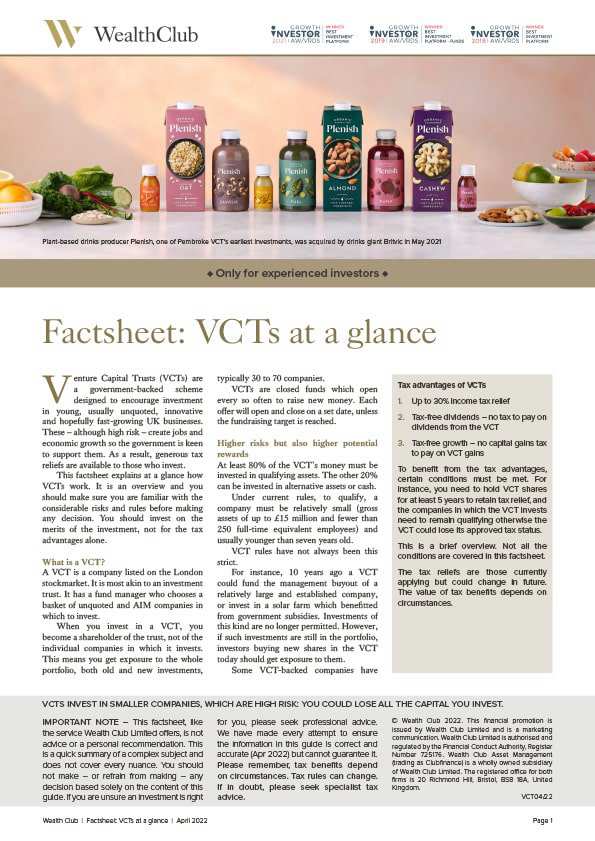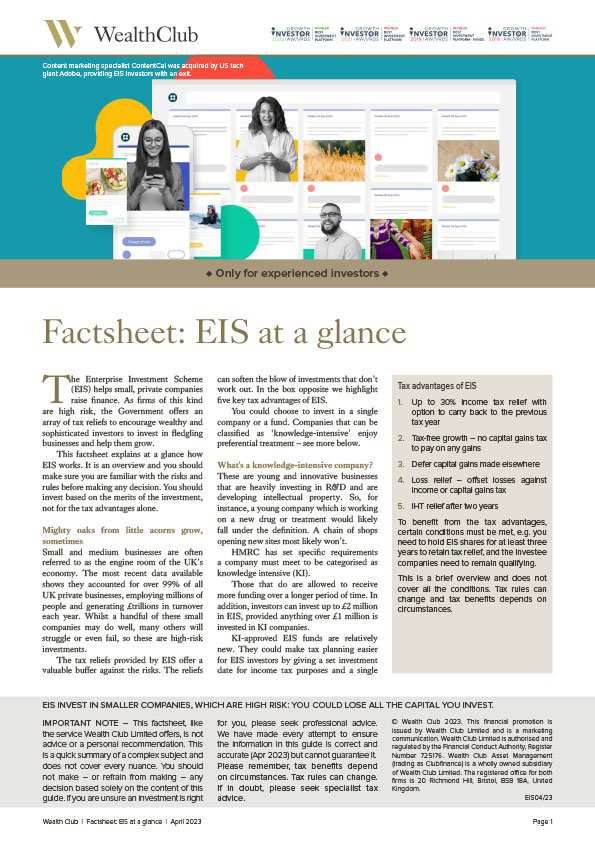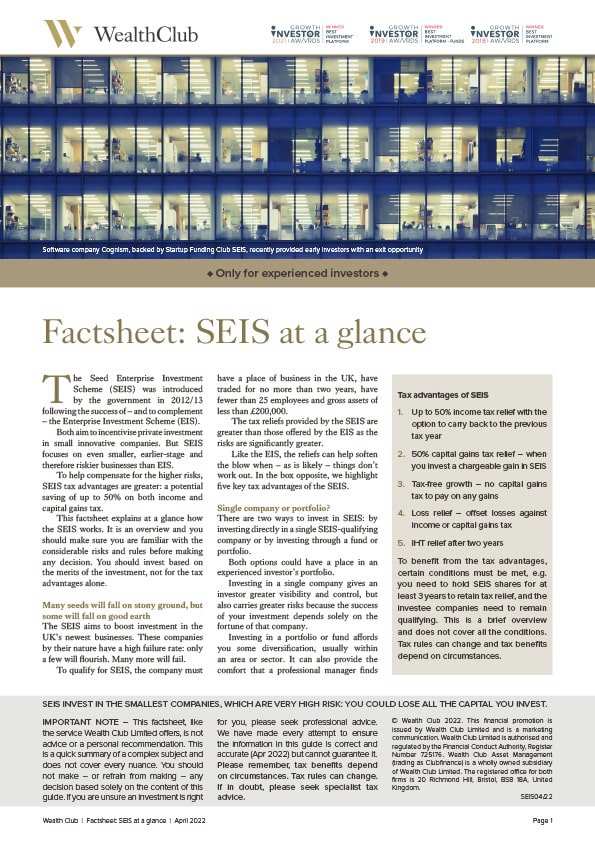
Don't invest unless you’re prepared to lose all the money you invest. This is a high-risk investment and you are unlikely to be protected if something goes wrong. Take 2 mins to learn more.
Estimated reading time: 2 min
Due to the potential for losses, the Financial Conduct Authority (FCA) considers this investment to be high risk.
What are the key risks?
- You could lose all the money you invest
- If the business you invest in fails, you are likely to lose 100% of the money you invested. Most start-up businesses fail.
- You are unlikely to be protected if something goes wrong
- Protection from the Financial Services Compensation Scheme (FSCS), in relation to claims against failed regulated firms, does not cover poor investment performance. Try the FSCS investment protection checker here.
- Protection from the Financial Ombudsman Service (FOS) does not cover poor investment performance. If you have a complaint against an FCA-regulated firm, FOS may be able to consider it. Learn more about FOS protection here.
- You won’t get your money back quickly
- Even if the business you invest in is successful, it may take several years to get your money back. You are unlikely to be able to sell your investment early.
- The most likely way to get your money back is if the business is bought by another business or lists its shares on an exchange such as the London Stock Exchange. These events are not common.
- If you are investing in a start-up business, you should not expect to get your money back through dividends. Start-up businesses rarely pay these.
- Don’t put all your eggs in one basket
- Putting all your money into a single business or type of investment for example, is risky. Spreading your money across different investments makes you less dependent on any one to do well.
- A good rule of thumb is not to invest more than 10% of your money in high-risk investments.
- The value of your investment can be reduced
- The percentage of the business that you own will decrease if the business issues more shares. This could mean that the value of your investment reduces, depending on how much the business grows. Most start-up businesses issue multiple rounds of shares.
- These new shares could have additional rights that your shares don’t have, such as the right to receive a fixed dividend, which could further reduce your chances of getting a return on your investment.
If you are interested in learning more about how to protect yourself, visit the FCA’s website here.
The most recent FT annual survey of readers revealed over half expect a bigger bonus payout this year. The top priority for most was to invest it.
Any plans, of course, will have to take into account the usual tax haircut. After additional rate income tax and National Insurance, a £100,000 bonus, for instance, could be shaved right down to £53,000.
What could you consider to reduce that? Here we give an overview of three options that could help you secure valuable tax savings and keep more of your money working for you.
They could be particularly attractive to investors who have already used up their pension allowance.
Important: The information on this website is for experienced investors. It is not a personal recommendation to invest. If you’re unsure, please seek advice. These investments are for the long term. They are high risk and can fall as well as rise in value: you could lose all the money you invest. Tax rules can change and benefits depend on circumstances.
Where to invest tax-efficiently and reduce your income tax bill?
If you’re an experienced investor comfortable with the risk of investing in young businesses – an important engine of the UK economy – the government offers generous income tax relief via its Venture Capital Schemes: Venture Capital Trusts (VCTs), Enterprise Investment Schemes (EIS) – both funds and Single Company Investments – and Seed Enterprise Investment Schemes (SEIS).
VCT, EIS and SEIS are designed to encourage investment in young and ambitious – and high risk – British companies, the growth engine of the economy.
In recognition of the risks, the tax breaks include up to 30% (VCTs and EIS) or 50% (SEIS) income tax relief and tax-free growth.
In addition, VCTs offer tax-free dividends. Meanwhile, EIS and SEIS offer relief against capital gains and inheritance tax liabilities.
As a rule of thumb, the greater the risks involved, the more valuable the reliefs available. Tax benefits depend on circumstances and tax rules can change.
You can view a quick side-by-side comparison of the tax reliefs below.
How do VCT, EIS and SEIS tax reliefs compare at a glance?
The below is a brief outline based on current rules: there are detailed conditions and rules you should consider carefully before investing. If unsure, seek advice. These are high-risk investments and you should invest on the merits of the investment, not for the tax advantages alone.
| VCT | EIS | SEIS | |
|---|---|---|---|
| Maximum investment per tax year | £200,000 | £2,000,000* | £200,000 |
| Carry back | no | available | available |
| Income tax relief | up to 30% | up to 30% | up to 50% |
| CGT relief/deferral | no | deferral | up to 50% |
| Tax-free dividends | yes | no | no |
| Tax-free growth | yes | yes | yes |
| IHT relief** | no | yes | yes |
| Loss relief | no | yes | yes |
* Provided anything over £1 million is invested in Knowledge Intensive companies.
** From 6 April 2026 100% IHT relief on EIS and SEIS private companies will be limited to the first £1 million of qualifying assets (including private companies and agricultural property), with the remainder eligible for 50% IHT relief (an effective IHT rate of 20%). Any qualifying S/EIS companies quoted on AIM will be eligible for 50% IHT relief (an effective IHT rate of 20%).
Tax rules can change and benefits depend on circumstances.
VCTs
A VCT is in many ways similar to an investment trust. It is a company listed on the London Stock Exchange that raises money and uses it to invest in young, innovative and often privately-owned companies.
When you invest, you could receive:
- Up to 30% tax relief – save up to £60,000 on your income tax bill when you invest in newly issued VCT shares
- Generous allowance – invest up to £200,000 per tax year
- Tax-free dividends – no need to declare VCT dividends on your tax return
- Tax-free growth – no CGT on gains
EIS
The EIS (Enterprise Investment Scheme) incentivises investment in small and usually privately owned or AIM-quoted companies. You can invest directly in individual companies or in an EIS fund, where the fund manager makes the investment decisions.
When you invest, you could receive:
- Up to 30% income tax relief – up to £3,000 saving on a £10,000 investment
- Carry back – potential to use the income tax relief against a previous year's tax bill
- Very generous allowance – up to £1 million per tax year (or £2 million if at least £1 million is in knowledge-intensive companies)
- Tax-free growth
- Capital gains deferral – defer capital gains from other investments, potentially indefinitely
- Loss relief – offset any future losses against your income
- Inheritance tax relief – potentially pass on your investment free of IHT
SEIS
The Seed Enterprise Investment Scheme (SEIS) is designed to complement the EIS. SEIS companies are even smaller and younger than EIS ones, hence riskier. Accordingly, SEIS tax reliefs are more generous.
When you invest, you could receive:
- Up to 50% income tax relief – up to £5,000 saving on a £10,000 investment
- Carry back – potential to use the income tax relief against a previous year's tax bill
- Generous allowance – £200,000 per tax year
- Tax-free growth
- Up to 50% capital gains reinvestment relief – halve the CGT due on gains from elsewhere
- Loss relief – offset any future losses against your income
- Inheritance tax relief – potentially pass on your investment free of IHT
Guides & factsheets
Find out more
Wealth Club aims to make it easier for experienced investors to find information on – and apply for – investments. You should base your investment decision on the offer documents and ensure you have read and fully understand them before investing. The information on this webpage is a marketing communication. It is not advice or a personal or research recommendation to buy any of the investments mentioned, nor does it include any opinion as to the present or future value or price of these investments. It does not satisfy legal requirements promoting investment research independence and is thus not subject to prohibitions on dealing ahead of its dissemination.



